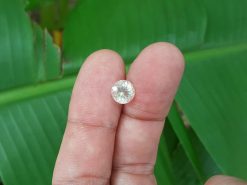Sanidine

Sanidine orthoclase feldspar mineral chemical formula.
Buy natural sanidine in our shop
The yellow variety of microcline orthoclase feldspar.
Sanidine chemical formula
The high temperature form of potassium feldspar. Sanidine orthoclase feldspar mineral chemical formula: K(AlSi3O8). It is found most typically in felsic volcanic rocks. Such as obsidian, also rhyolite and trachyte. It crystallizes in the monoclinic crystal system.
Orthoclase is a monoclinic polymorph stable at lower temperatures. At yet lower temperatures, microcline, a triclinic polymorph of potassium feldspar, is stable.
Due to the high temperature and rapid quenching. It can contain more sodium in its structure than the two polymorphs that equilibrated at lower temperatures. Sanidine and high albite constitute a solid solution series. With intermediate compositions termed anorthoclase.
otherwise, exsolution of an albite phase does occur. Resulting cryptoperthite can best be observed in electron microprobe images.
Sanidine mineral
The stone is characteristic of rhyolites and also silico-potassic magmatic rocks solidified. In a rapid temperature drop. It is formed above 700 ° C. Usually in large, isolated crystals.
Polymorph of stable alkaline feldspar at high temperature.
It corresponds to the maximum degree of disorder. Each tetrahedron contains on average 25% aluminum and 75% silicon. Otherwise, it is the polymorph that intervenes at the highest temperature.
Orthoclase sanidine feldspar
Orthoclase feldspar is an important tectosilicate mineral which forms igneous rock. The name is from the Ancient Greek for “straight fracture”.
Identification
It is very difficult to differentiate a sanidine from a citrine. Because most of their properties are identical. Their color, as well as their refractive index and their specific gravity are almost identical. The determining property is the optical figure, under polariscope. Citrine will display the typical optical figure of quartz. otherwise It differs completely from that of potassium felspar.
The differences between orthoclase and also microcline felspar is visible by examination. The microcline tends to have a more frank and also deep coloration, in the case of amazonite. Sanidine does not show a lamellar twin, which is common in microcline. It is also possible to see streaks on cleavage surfaces in stone. Anostosis and It usually appear as flat crystals.
Sanidine meaning and properties
The following section is pseudo scientific and based on cultural beliefs.
Since ancient times, there are cultural beliefs that crystals are believed to heal afflictions in human beings. Beyond their everyday use of beautification in ornaments and decoration, a dedicated therapy involves using crystals for healing chronic ailments.
This practice which utilizes. Certain crystals are believed to be associated with prominent planets and channelize the energies from these planets into wearer’s body.
This crystal has a gentle feminine energy that works on the solar plexus. Hold on this energy centre for relief from emotional stress, menstrual tensions and for grief.
Helps with issues tied up in self worth and frees one from reacting to situations with feelings of guilt.
FAQ
What does Sanidine mean?
a variety of orthoclase in often transparent crystals in eruptive rock (as trachyte) that is thought to form at higher temperatures than adularia. Called also glassy feldspar.
Is sanidine intrusive or extrusive?
Trachyte, light-coloured, very fine-grained extrusive igneous rock that is composed chiefly of alkali feldspar with minor amounts of dark-coloured minerals such as biotite, amphibole, or pyroxene. Compositionally, trachyte is the volcanic equivalent of the plutonic (intrusive) rock syenite.
Why does sanidine occur in volcanic rocks?
It is found only in young volcanic discharges or (volcanic) rocks (rhyolite, trachyte and dacite). It forms by the crystallization of lava at high temperatures and its rapid cooling. The stone crystallizes orthoclase during slow cooling of lava.
Natural sanidine for sale in our gem shop
We make custom made sanidine jewelry as engagement rings, necklaces, stud earrings, bracelets, pendants… Please contact us for a quote.














